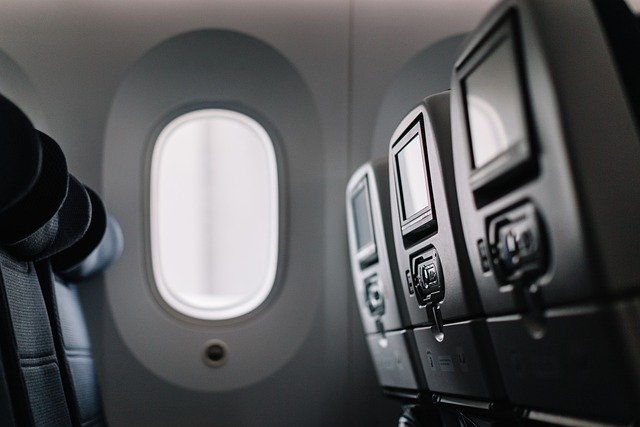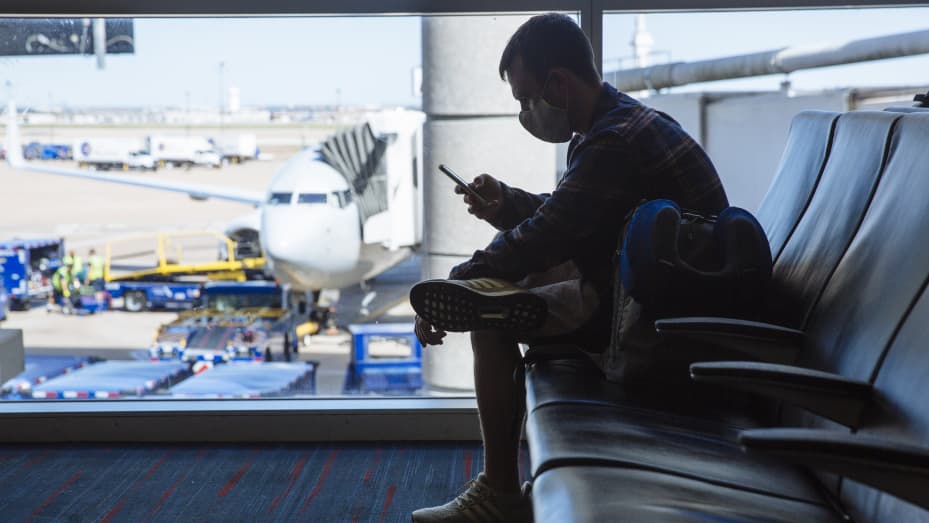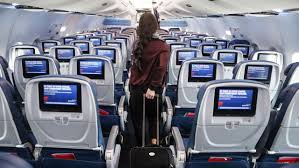Has the question of Sunscreen When Traveling By Air? This question caught my attention a few days ago. I don’t fly so much anymore, but that is not true for everyone as we have many newscasts about the problems at the airports.

Should we wear sunscreen while traveling by air? What do you do? We already are aware of the need for sunscreen as a part of our daily skincare routine. Yes, even on the days you stay in the house!
I travel so little anymore, that my exposure is limited. But not everyone is in my shoes. People who have to travel a lot are exposed to a lot of UVA rays. These aren’t the ones that cause sunburn, but they do cause early aging. I don’t want that either! Wrinkles and lines on my face!
The rays you are exposed to are stronger and even with the UVB blocked with the windows, you should make sure you use sunscreen.
This is true as well at the terminal. They all have so much glass, lots of light, and reflections.
I have been aware of dry skin when flying but was blissfully ignorant of the UV dangers. An article states that people who work in the flying world, piolets, and service techs have a higher rate of skin cancer than normal none flying people.
While some of this was lifestyle-related in that the hours of the off time tended to put them where they could be our in the pool, or on the resort beaches more. The hours in the air had a bearing as well.
Since we are just now becoming aware of the need for daily sunscreen regardless of our occupation, there is a large number of people out there who are being exposed and overexposed.

Skin Cancer. org Warns Us About Traveling
The research is in about the dangers employees of airlines, pilots, and crew support for the cabin are having more than the normal occurrence of skin cancer.
“The available evidence shows that airline pilots and cabin crew have about twice the risk of melanoma and other skin cancers than the general population, with pilots more likely to die from melanoma.” This information is from, The National Libriary of Medicine.
While a passenger would have the accumulative number of hours of UV rays exposure, depending on your lifestyle, you are getting more exposure. I could not find actual studies of passanger-related research, there was no mention that it was entirely risk-free for your skin.
While the glass windows and windshields of planes have treated glass, they only treat it for UVB rays. That means that it takes lots of exposure to get a sunburn. It can happen, but not often. You have to be flying a good number of hours to sunburn.
However, sometimes the person may be taking medications that put their skin in a more sensitive condition. Due to the hours, people who are in the travel industry are exposed to, these unexpected incidents do occur. Sun damage is accumulative. The hours add up.
Of course, the route that is flown, the altitude, time of year all play a part in the amount of damage to our skin. You are just so much closer to the sun high in the air.
Those of us who are just riders on any of kind of transportation have your risk of exposure as well.
These warnings are not limited to just planes. It also applies to trains, buses, and automobiles. In an automobile, there have been many cases traced to too many commuting hours. Truck drivers are good examples of an industry that is working hard at getting the message of how important sunscreen protection is.
Then you add the allergic problem to the issue. Awareness of our skin protection is important.
How To Protect Your Skin If You Are Allergic To Sunscreen
When you are allergic to sunscreen, you do have a few choices for protecting your skin, but remember, if travel is where you are getting exposed, you are usually protected from sunburn by the glass in the vehicle you are traveling in.
You are not protected from the early aging from UVA rays. If you apply sunscreen, your skin reacts and causes problems. So, what are the options?
The most obvious is to use mineral sunscreen if you can. However, how many times are you supposed to put solutions on your skin before giving it up?
Covering your skin will prevent more sun damage. It is important to wear sun blocking clothing. Wearing a mask is important to protect your skin on your lower face. There are masks that are more like a veil. They can protect your skin from UVA rays.
Are you seeing many face veils in the general public? Probably not. However, keeping your skin safe from UV rays that cause early aging can be done. Did you see several styles and many colors on the pages of UPF clothing catalogs?
For me, this will not be an answer for in-flight wear. I can see that the cabin crew would have trouble with a veil. However, they managed to wear masks. If they are aware of the damage they are getting every day at work, a mask may be acceptable.

Sunscreen Is A Tool To Help Protect Your Skin
Most people seem to forget, that no sunscreen is 100 percent effective at preventing burning and skin damage. Sunscreen can help increase the amount of time you can be outside and stay safe. However, sunscreen does not offer a full day of protection with no sun damage!
The amount of time spent you spend outside safely is determined by the SPF of the product used. According to Science Direct Findings, SPF 100 is protecting better than SPF 50. Always make sure you are using an SPF of at least 30.
Remember that the higher SPF will not last longer, it will lose its protecting power just as the lower SPF will. Just being a higher protection factor doesn’t mean you can skip reapplication.
If you are allergic, and can’t use commercial sunscreens, you can get some protection from the sun’s UV rays, using raspberry seed oil. However, there is no SPF. Being out in the sun is only safe for you in very short time spans.
Again, sunscreen is a tool to use to protect your skin. You have to use it properly to get the protection it promises.
How Will You Protect Your Skin When Traveling?
A study done in 2015 concluded that there is a relation between frequent flying and skin cancer. This study was published in the Journal of the American Medical Association Dermatology.
The study also found an increased incidence of melanoma in pilots and cabin crew.
During the study, the researchers discovered that the UVA dose at 30,000 feet in Las Vegas, Nevada, was approximately an easy comparison to the exposure to the UVA dose in a UVA-only tanning bed.
With a few more calculations, it was shown that pilots flying for 56.6 minutes at 30,000 feet receive the same amount of UVA carcinogenic effective radiation as they would from a 20-minute tanning bed session!
The researchers note this radiation could be even higher when flying over clouds and snowfields, which can reflect up to 85 percent of UV radiation.
Again, we who are just passengers do not expose ourselves as pilots do.
The easy way to prevent sun damage while flying is of course to use sunscreen.
It is recommended to apply a layer of SPF 30 or higher with UVA and UVB protection on all exposed areas of your body. Especially on your face, arms, chest, and neck an hour before you fly. The reapplication should be a small amount every three hours after that.
Physical sunscreens that are based on zinc oxide and titanium oxide can clog the pores of people who have sunscreen allergies. Or just because you have sensitive skin. Not a lot of help for people with sensitive skin. What do you think is your solution?
Pay Attention To Who Is Paying For Research About Sunscreen
When you have extra sensitive skin, or if you are allergic to sunscreen. Is the study trying to prove how safe and how well the product works? Be aware of whose advice you are taking.
There is little help for those with sunscreen allergies. Sun blocking clothing is the one sure way to keep your skin safe. It may be hard to wear a wide-brimmed hat on a flight! However, you can wear a loose-fitting hoodie pulled up over your head and get a good bit of coverage from UVA rays.
Now that you know what you are protecting your skin from, you have options. You will have to take a few precautions, but flying can be safe for you.
For me, I think that passengers should have little trouble. However, I’m not extra sensitive.
I do think that it is possible to travel safely and keep your skin protected from sun damage. Close your window if you can.
Finding some halfway point that allows you to have some control over your exposure is important. I am hoping that by being more aware of the things I can control, the things that are harder to avoid will be less damaging.
Remember sun damage is cumulative. Limiting the exposure minutes will make a difference.
What Do You Wear When Flying?
We all have our own ideas of what is comfortable when we are traveling by plane.
For me, I like to be comfortable to set for a while. So the clothing should move with me. I usually like to layer with another easy-fitting sweater, sweatshirt, or hoodie.
I no longer fly international, so the flights aren’t usually extra long, but still, comfort is important. It is important to me to have comfy shoes, not flip-flops of any kind. Actually, there is a gap in my physical development that has me never learning to walk in flip-flops!
What is your favorite travel wardrobe? Will you be more aware of protecting your skin? Do you think are more aware of what can be done to protect themselves from the sun’s UV rays?

Sami’s Take On Sunscreen When Traveling By Air
I do think that we can enjoy a decent amount of skin protection from the UV rays in sun while traveling. I have been interested in a sun wrap, and a sun blanket from Coolibar.
They seem to have a good handle on protecting our skin when we are in the sun. Their fabrics feel soft and the colors are so pretty.
Had we planned a trip by car this summer, I had thought I wanted the sun cape that I saw in the online catalog. However, my husband is still having some health issues from a year and a half ago, and the heat made us decide to just stay home.
With the dry year that has accompanied the heat, we would not have had very pretty scenery along any route we choose. When we got to where we liked to go, it would have been too hot to be out and enjoy the areas. More staying in. We choose to stay at home.
However, as I am now aware of the dangers to my skin and the skin cancer risk where we live, traveling in a lightweight sun blocking shirt that fits loosely and has long sleeves would be my go-to shirt. Loose-fitting long pants that would protect me from sunburn along the way make sense.
Then add sunscreen where my skin is exposed. When sunscreen allergies exclude using this protection for you, search for lightweight gloves of sun blocking fabric or UPF-rated gloves.
Getting out at the different sites we wanted to investigate would not have involved a hike, as it did when we were younger. How much easier traveling with a family is when you allow some time for a good leg-stretching hike.
Do You Take Advantage Of Breaks For Your Family When Traveling?
Unfortunately, while my family was still home, young and vacationing with us, we didn’t have the advantage of well-written articles to give us advice on making the trip easier by getting the family out and into tennis shoes and hiking a short trail, searching for the local birds or other critters we might spot.
Starting with an early in the day hike, back to the hotel, shower, and dress for some time in the vehicle. Then stop early enough to have another family swim time or hike time, or whatever was offered in the area.
Working skin protection into your family’s life will allow them to live with a lower risk of skin cancer. Learning to use what is available for us to use to slow down our risks of skin cancer can make us healthy thorough out our years.
Understanding the relationship of healthy skin to a healthy life is important. Carcinoma Refresh in the post helps with your skin’s importance to your overall health.
Do you have your loose-fitting shirt with long sleeves of a tightly woven fabric handy for when you will be exposed to the sun? Your wide-brim hat and 100% UV blocking sunglasses? That is a sound start for a sun blocking wardrobe.
Thank you,
Sami